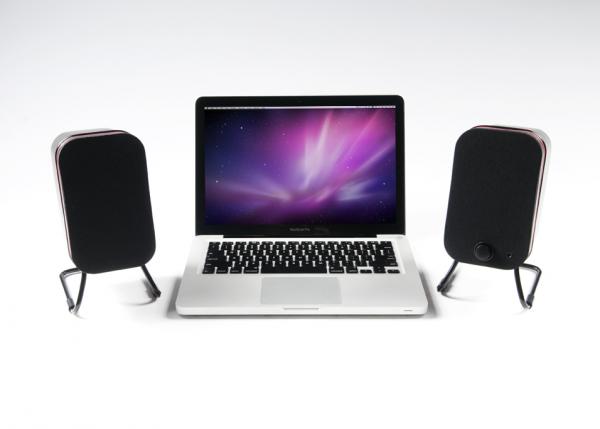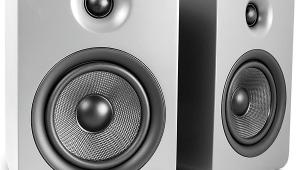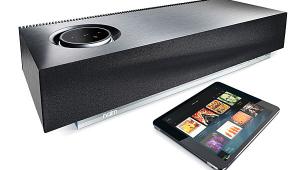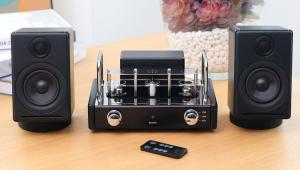Power to the Speakers: Three New Active Desktop Systems

Were we to travel to, say, Jupiter, and abduct its leading audio engineer (turnabout is fair play, after all), we might want to ask him (or it) this question: what’s the very best way to design a loudspeaker for the reproduction of high-fidelity music?
There’s no doubt in my mind as to how our Jovian guest would answer: “Active/powered!”
Any tech-minded person who’s spent ten minutes thinking about the problem has surely reached the same conclusion. When an engineering team designs a powered, or “active” speaker (the terms are interchangeable) with amps right on board, the list of passive-speaker pitfalls they sidestep is long. First, designers abandon any worries about buyers applying too much power (or worse, too little power, driven too hard) and thus they throw out the possibility of melting voice coils. They know what amps will be used, because they’re building them right in. Next, concerns over response changes induced by odd amplifier output impedances, funky speaker-cable capacitance, or long wire-runs disappear, since none of these situations can possibly occur. At the high end of things, active speakers can eschew power-sucking, response-error-imposing, phase-problem-inducing passive crossover filters altogether, in favor of line-level circuits that do their filtering upstream of the power amp sections and thus far less invasively. (Though as near as I can determine, alas, the trio below are all one-amp-channel-per-speaker designs.) And — hallelujah! — it is simply impossible, without malice aforethought, for a user to connect a fully active-speaker stereo pair out of phase.
But what active designers stand to gain is perhaps more important. Each speaker’s amplifier can be power- and response-matched to just those drivers, and the crossover filters (if they come before the power amps) can be light years more sophisticated than the brute-force passive crossovers found in virtually every conventional speaker. (And if they operate in the digital domain they can perform astonishing feats of sleight-of-ear, like delivering filter-slopes precisely tailored to the response of each driver, and imposing corrective equalization to smooth, flatten, and extend transducer response and correct phase anomalies.) Even without internal biamplification, DSP-enabled active designs can perform dynamic tricks to extend clean peak playback levels, improve bass extension, correct response errors, make speaker overload or damage impossible, and even perform time-domain tweaks to upgrade imaging and perceived spaciousness. (And all three of our speakers here do at least a few of these things.)
So why would anyone — let alone everyone — buy a passive speaker? Excellent question, just as it’s always been. Years and years ago I worked with Tom Holman, father of THX, late of USC, and currently (according to rumor) all-things-audio guru at Apple. Earlier still Holman developed the virtually forgotten Powered Advent loudspeaker, a large, internally biamped two-way visually identical to the then best-selling passive Large Advent, except for added weight and a pilot light — same size, same cabinet, same finishes. They sounded astonishingly good, easily besting anything then on the market at less than three times the price — five times, if concert hall levels were involved.
But nobody — nobody — would buy them. Why? Because you could buy a pair of conventional, passive Large Advents and a crappy 35-watt receiver for the same money — and 99.9 percent of Advent buyers did.
Skip-cue to 2012, when a powered-speaker renaissance may be upon us thanks to — what else? — the iPod/iPhone/MP3/iTunes revolution. After all, a pair of powered speakers is simply a smartphone dock, minus the dock, writ larger (or at least smarter). And many are pitched to a more serious sort of playback pioneer: audiophiles, 2012-style.
Consequently, Sound+Vision has done that thing we do: round up a trio of recent, compact, multi-purpose powered monitors for ears-on assessment. Because of the daunting bulk of data (and low pay), I’m going to leave the minutiae of features — drivers, power specs, inputs and outputs, finishes, and accessories — to your own web scraping, and shorthand the listening experiences as efficiently as possible.
- Log in or register to post comments






























































